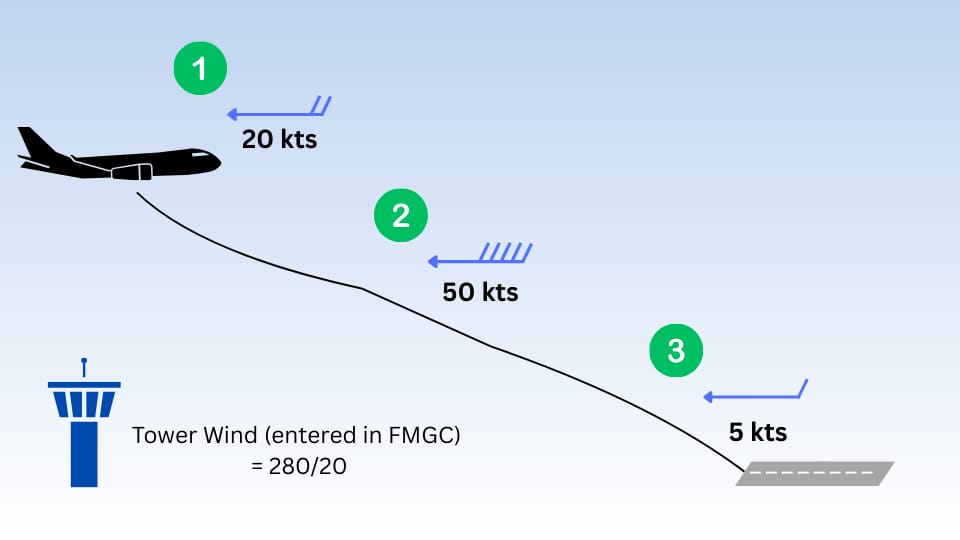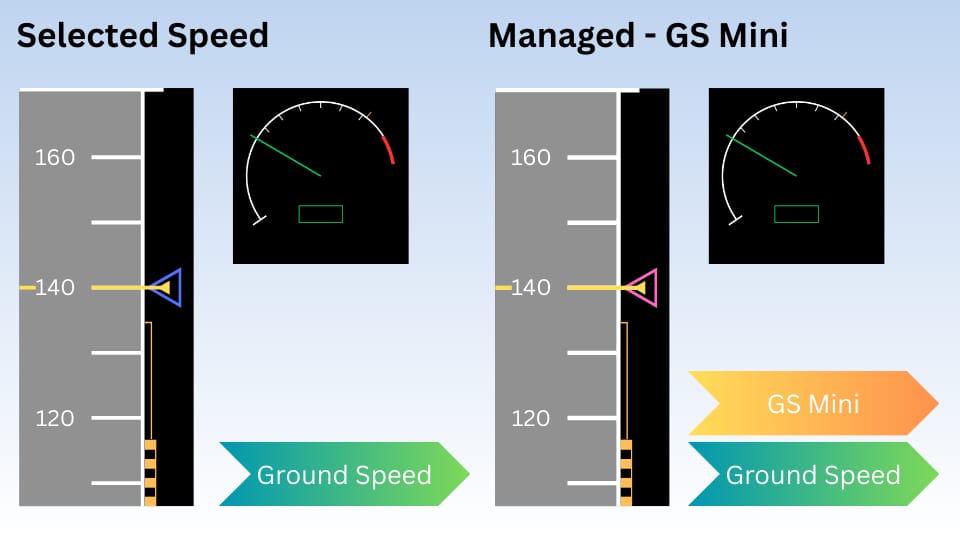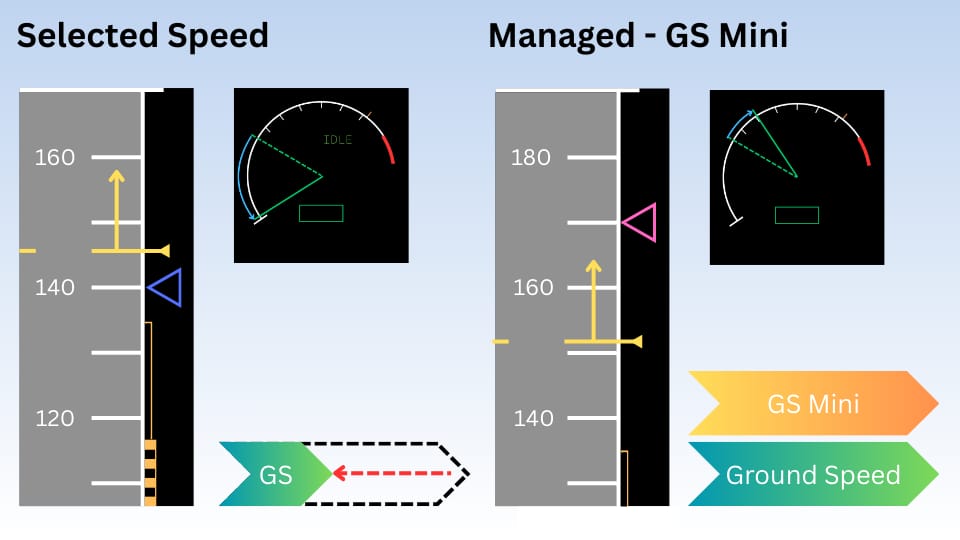👋 Hey, it’s Simon.
There’s no getting around it.
Ground Speed Mini has to be the single most misunderstood feature of the A320.
Ask ten pilots what it does and you’ll get twelve different answers!
So this week, we’ll break it down properly:
Why it matters
How it actually works
How to fly with it
And more…
Find the TLDR here.
DEEP DIVE
✈️ The Approach Problem
First let’s look at how most conventional aircraft (like the 737) fly the approach.
You plan for wind by adding it to VREF - your reference landing speed.
Typically half the headwind plus some or all of the gust.
So, say the headwind is 20 kt and gusts are up to 30 kt. You’d likely set:
VREF + 10 + 15 = VREF + 25 kt
You bug that speed and fly it all the way to touchdown — no matter what the wind actually does.
But what happens if that extra headwind suddenly disappears?
Because you're holding a fixed IAS you suddenly lose 20-30kts!!
You're left dangerously low on energy just before touchdown — and have very little time to recover.
This is the problem GS Mini was built to solve.
It dynamically adjusts your target IAS to protect your energy margin in case that headwind vanishes.
Note: The airbus behaves just like a conventional aircraft if you are in selected speed. GS Mini only works when speed is managed.
✈️ How Airbus Does It
Ground Speed Mini is all about energy.
It adjusts your target IAS, in real time, to protect against a sudden headwind loss.
Another way to think about it is GM mini tries to maintain your ground speed regardless of the wind changes on the approach.
It works when:
You’re in managed speed
The approach phase is active
The actual headwind is stronger than the tower wind you entered in the PERF APPR page
If the actual wind is higher, GS Mini bumps your IAS target up.
Then when the wind drops, the target slides back to your planned VAPP.
Meaning your groundspeed stays at or above GS Mini — even if the wind drops.
Just smooth, protected energy all the way down 😎

QUICK REMINDER
VLS & VAPP
Before we look at an example we need to know what VLS and VAPP are.
I’m sure you remember, but just in case… 😬
📉 VLS: is the lowest selectable speed for the autopilot and autothrust.
Even if the selected target speed is below this, the A/THR will maintain VLS as a minimum.
The calculation of VLS gets a little funky.
But in essence its the stall speed at a given config multiplied by a factor of 1.23.
(Quick note: This is also why VLS increases when you extend the speedbrake — deploying it increases drag and reduces lift, which raises the stall speed! Isn’t physics fun!)
If you want more detail on how VLS is calculated have a look here.

Top of the amber hook is VLS
📈 VAPP is the final approach speed.
It’s based on the VLS of the landing configuration.
For Airbus aircraft, in normal operations, the VAPP is defined by:
VAPP = VLS Landing CONF + APPR COR
When computed by the FMGC, the APPRoach CORrection (APPR COR) used is:
APPR COR = 1/3 Headwind with 5kt ≤ APPR COR ≤15 kt
In other words:
If 1/3 of the headwind is less than 5 kt → use 5 kt
If 1/3 of the headwind is more than 15 kt → cap it at 15 kt
If it's between 5–15 kt, just use the actual 1/3 value
🧮 Example:
VLS = 132
Tower Wind = 100/21 → 1/3 = 7
→ VAPP = 139
Easy! 😬
EXPLANATION
🧠 How GS Mini Works (with a Simple Example)
GS Mini creates a baseline groundspeed the aircraft must maintain on approach, even if the wind drops.
Here’s the core logic:
GS Mini = VAPP − Tower Headwind
Target IAS = GS Mini + Actual Headwind (from ADIRS)
Continuing with our example:
VLS = 132
Tower Wind = 100/21 → 1/3 = 7
→ VAPP = 139
→ GS Mini = 139 – 21 = 118 kt
If actual wind = 30 kt → IAS Target = 118 + 30 = 148 kt
🧰 Lets look at it a different way

We’re landing on runway 28 and the tower wind is given as 280/20.
Initially the wind is 20 kt.
Then it increases to 50 kt.
Then it decreases to 5 kt.
At Point 1 on the Approach:
VAPP = VLS + APPR COR
VAPP = 134 + 6 = IAS Target 140 kt
GS Mini = VAPP - Tower Wind (20kts) = GS Mini 120 kt

✅ So the IAS target is 140 kt
✅ The actual wind matches the tower wind — no gusts, no surprises
Happy days.
There’s no difference between flying in managed speed with GS Mini active and a conventional aircraft (or selected speed).
At Point 2 on the Approach:
The actual headwind increases to 50 kt.
Here’s where it get’s interesting… (maybe…)

🟦 Selected Speed
IAS increases as the headwind increases
But because 140 kt is bugged, the autothrust sees an overspeed
→ It reduces thrust — possibly to idleResult: Groundspeed drops — even though IAS looked fine
The aircraft is now below GS Mini → low energy state
🟥 Managed Speed — GS Mini Active
GS Mini = 120 kt
Actual headwind = 50 kt
IAS target = 120 + 50 = 170 kt
→ IAS target increases to 170 kt
→ Autothrust adds power to smoothly reach the new target
→ Energy is preserved
→ Groundspeed is maintained at GS Mini — 120 kt
✈️ At Point 3 on the Approach:
The actual wind drops to 5 kt.

🟦 Selected Speed
IAS decreases as the headwind drops
Engine thrust is already low — possibly idle
Aircraft energy state is now low
✅ At best: you'll need a large thrust increase, which may destabilise the approach
🚨 At worst: you’re near VLS — or even approaching stall speed
🟥 Managed Speed — GS Mini Active
GS Mini = 120 kt
Actual headwind = 5 kt
IAS target = 120 + 5 = 125 kt
But…
GS Mini logic won’t let the bug drop below VAPP (140 kt in this case)
✅ So the IAS target stays at 140 kt → You cross the threshold at the briefed speed — but with your energy margin fully preserved! 🤗
TLDR
✈️ GS Mini in 60 Seconds
What is it?
A function that protects your energy on approach by ensuring your groundspeed never drops below a minimum safe value — even if the headwind vanishes.
When does it work?
Managed speed active
Approach phase active
Tower wind (not gust) entered in the PERF APPR page
What does it do?
If the actual headwind is stronger than what you entered, GS Mini increases the IAS target so your energy state is preserved.
If the wind drops, the speed smoothly comes back down.
Why should you care?
Because losing headwind late in the approach can dump you into low energy at low altitude — and jet engines don't spool up fast.
How to fly with it:
✅ Use managed speed on final
✅ Enter the steady tower wind (not the gust)
⚠️ If the bug climbs near VFE, use selected briefly — then return to managed
🛑 If the approach isn’t stable, go around. GS Mini is smart, but not magic.


